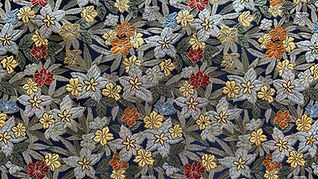
PRODUCTION
Making of Nishijin-ori brocade startfrom sakizome, meaning that the yarns are dyed before the fabric is woven, withthe motifs (nature, seasons, traditional patterns…) in mind and while it is being woven using Jacquard style (a weaving technique where patterns are woven directly into the fabric, rather than printed or embroidered, using a special loom. Named after its inventor Joseph Marie Jacquard).
Yarn is the basic material used in weaving. It is a continuous strand of fibers that can be made from various materials such as cotton, wool, silk, or synthetic fibers like polyester or nylon. Yarns are typically produced by spinning fibers together to create a long, cohesive strand. Yarn can vary in thickness, texture, color, and material, and it is the primary element that forms the basis of woven fabrics. Some Nishijin-oriweavers, for example, make their own silk, gold, metal yarns.
Threads are strands of yarn used in the process of weaving to create fabric.When yarns are interlaced vertically (warp) and horizontally (weft) on a loom, they form the structure of the fabric. These individual strands of yarn are commonly referred to as threads when they are being woven together on a loom.
The weaving of Nishijin-ori brocades consists of 5 steps and 20 processes. Here is a brief introduction of 11 of these processes.


1. DESIGN
The weavers will design the fabric, creating colors, motifs, patterns and textures, according to his inspiration or the order received by designers and customers.
2. PLAN
A plan is needed for weaving. An enlarged design is drafted with different colors on a sheet of section paper, making a map of the whole texture.
3. PERFORATION
Small holes are perforated on the long rectangular thick cards according to the plan. These cords are used to give instruction to the warps up and down, vertical movement.
4. TWISTING
Twisting is the process that allows the creation of the desired texture effects and impart various delicate touches to the Nishijin-ori woven fabrics. Combining a certain amount of very thin yarns and twisting them together will yield threads of different thicknesses.
5. DYEING OF YARNS
The weavers, knowing the colors that they will need, prepare the yarn, the dyes and dye the threads before weaving. This is a lengthy very technical process requiring time and skills.


6. REEL
Dyed yarns are reeled and wounded on spools, so that they could be treated easily for the next processes.
7. ARRANGING WARPS / WARPING
Nishijin-ori textiles require between 3,000 and 10,000 warps to be rolled on drums according to the length and number required for the design. In weaving, the term "warp" refers to the set of lengthwise yarns that are held in tension on a loom.
These yarns are typically arranged parallel to each other and are interwoven with the “weft” yarns to create thefabric. "Warping" is the process of preparing these lengthwise yarns, which involves winding them onto a beam or spool in a specific order and tension, readying them for the weaving process.
8. SOKO
"Soko" is an instrument that enableswefts to go through warps. When yarns are interlaced vertically (warp) and horizontally (weft) on a loom, they form the structure of the fabric. These individual strands of yarn become threads when they are being woven together to become fabric.


9. HANDLOOM
Handloom is used for finer quality materials, such as gold yarns. Due to their precious and delicate nature, some yarns cannot be woven with electrical, mechanical looms.
10. FINGERNAIL WEAVING
This is the most refined and one of the oldest weaving methods. A special, traditional fingernail technique is required to produce the most delicate patterns.
11. ELECTRICAL LOOM
Electrical looms were introduced in the traditional Nishijin-ori industry to produce more efficiently on a larger scale.

